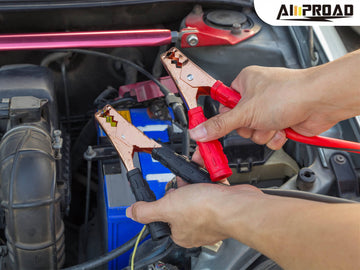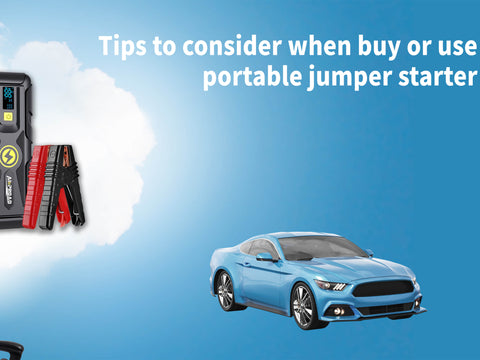
In today's rapidly evolving automotive landscape, the demand for portable and efficient solutions to common vehicle-related issues is on the rise. One such issue is the need for a reliable method of jump-starting a car without the assistance of another vehicle. In response to this demand, innovative technologies have emerged, offering drivers portable jump starter alternatives that don't require another car. Let's delve into the world of these cutting-edge solutions.
What are the limitations of traditional jump starters?
Traditional jump starters, while effective in their purpose, come with notable limitations. Firstly, they tend to be bulky and heavy, making them inconvenient to carry around, especially in compact vehicles where storage space is limited. Additionally, traditional jump starters require another car to provide the necessary power, meaning you're reliant on finding a willing and available vehicle nearby. This dependency on external assistance can be frustrating, particularly in isolated areas or during off-peak hours.
Furthermore, using traditional jump starters often involves navigating cumbersome cables, which can be daunting for those unfamiliar with the process and may increase the risk of accidents or damage to the vehicles involved. Additionally, traditional jump starters typically require periodic maintenance, including recharging the internal battery, which adds to their overall hassle.
Moreover, traditional jump starters may lack advanced safety features, such as protection against reverse polarity or short circuits, potentially putting users at risk of electrical hazards or damage to their vehicles' electrical systems.
Overall, while traditional jump starters serve their purpose in jump-starting vehicles, their limitations in terms of size, dependency on another vehicle, cumbersome cables, maintenance requirements, and safety features highlight the need for more advanced and user-friendly alternatives.
Why is there a need for new technology in jump starters?
The need for new technology in jump starters is driven by several factors, including the rising popularity of electric vehicles (EVs). Unlike traditional internal combustion engine vehicles, EVs cannot be jump-started using conventional methods due to their unique powertrain design. This presents a challenge for drivers who may encounter a depleted battery while on the road.
Furthermore, the increasing complexity of modern vehicle electronics and safety systems demands advanced battery booster technology capable of providing a safe and reliable power boost without risking damage to sensitive components.
Moreover, the desire for greater convenience and versatility prompts the development of jump starters that are compact, lightweight, and easy to use, catering to the needs of a diverse range of drivers, including those with limited automotive knowledge.
Additionally, advancements in battery technology and power management systems allow for the creation of more efficient and long-lasting jump starters that can deliver multiple jump starts on a single charge, ensuring peace of mind for drivers in emergency situations.
Overall, the emergence of new technology in jump starters addresses the evolving needs of today's drivers, offering solutions tailored to the challenges posed by electric vehicles, sophisticated vehicle electronics, and the demand for greater convenience and reliability.
Exploring New Technologies

Are there portable jump starter alternatives that don't require another car?
What are Lithium-ion jump starters?
Lithium-ion jump starters are innovative devices designed to provide a power boost to a vehicle's battery without the need for another car. They utilize lithium-ion battery technology to store and deliver sufficient energy to jump-start the vehicle's engine.
How do Lithium-ion jump starters work?
These jump starters work by connecting them directly to the vehicle's battery terminals. Once connected, the lithium-ion cells within the car booster pack discharge a high current, delivering the necessary voltage to start the engine.
What are the advantages of Lithium-ion jump starters?
Lithium-ion jump starters offer several advantages over traditional jump-starting methods:
- Compact and Lightweight: Lithium-ion jump starters are significantly smaller and lighter than traditional jump starter units, making them easy to carry and store in a vehicle's glove compartment or trunk.
- Portability: Due to their compact size, Lithium-ion jump starters are highly portable, allowing drivers to keep them on hand for emergencies without taking up much space.
- Fast Charging: These jump starters typically have fast charging capabilities, allowing them to recharge quickly between uses.
- Multiple Starts: Lithium-ion jump starters can often provide multiple jump starts on a single charge, making them reliable for repeated use or for assisting multiple vehicles in succession.
- What are the limitations of Lithium-ion jump starters?
- While Lithium-ion jump starters offer numerous benefits, they also have some limitations:
- Capacity Limitations: Lithium-ion jump starters may have limited capacity, which can affect their ability to jump-start larger vehicles or vehicles with severely depleted batteries.
- Maintenance: Like all rechargeable batteries, Lithium-ion jump starters require periodic recharging to maintain their effectiveness. Failure to keep the jump starter charged could render it unusable in an emergency.
-
Temperature Sensitivity: Extreme temperatures can affect the performance of Lithium-ion batteries, potentially reducing their effectiveness in very cold or hot conditions.

Can I use a portable power bank to jump start my car?
Yes, some portable power banks are equipped with jump-starting capabilities, allowing them to provide a power boost to a vehicle's battery in an emergency situation.
What are the limitations of using a power bank for jump starting?
While portable power banks can be convenient for jump starting, they may have limitations compared to dedicated jump starters:
- Lower Power Output: Portable power banks may have lower power outputs compared to dedicated jump starters, limiting their effectiveness for larger vehicles or vehicles with deeply discharged batteries.
- Capacity: Power banks designed for jump starting may have limited capacity, which can affect their ability to provide multiple jump starts or to assist vehicles with larger batteries.
Are there power banks specifically designed for jump starting?
Yes, there are power banks specifically engineered for jump-starting vehicles. But, how to boost a car with them? These specialized power banks often feature higher power outputs, advanced safety features, and rugged designs optimized for automotive use. They provide a reliable alternative for drivers seeking a compact and versatile jump-starting solution.
Are there new technologies that can jump start electric vehicles (EVs)?
While traditional jump starters are a reliable solution for gasoline-powered vehicles, they don't work for EVs. Let's explore the challenges and new technological solutions for jump starting electric cars:
What are the challenges of jump starting EVs?
There are two main reasons why traditional jump starters can't revive a dead battery in an EV:
- Different Battery Types: EVs rely on high-voltage lithium-ion batteries, which operate at a much higher voltage than the 12-volt lead-acid batteries found in gasoline cars. A traditional jump starter wouldn't be able to deliver the necessary voltage or current to kickstart an EV's high-voltage system.
- Safety Concerns: EVs have complex electrical systems designed to handle high voltage safely. Introducing a traditional jump starter into this system could create a safety hazard, potentially damaging the EV's delicate electronics or even causing an electrical fire.
- is there portable jump starter specifically designed for EV?
- Fortunately, new technologies are emerging to address the issue of dead batteries in EVs. Here's some good news:
- EV-specific Jump Starters: Manufacturers are now offering portable jump starters designed specifically for electric vehicles. These starters are built to deliver a safe and controlled high-voltage DC (direct current) output that can provide enough power to revive a depleted EV battery.
How do EV jump starters work differently from traditional jump starters?
Unlike traditional jump starters that simply provide a quick burst of power, EV jump starters function more like portable chargers. They typically contain a high-capacity lithium-ion battery pack and built-in safety features. Here's a breakdown of the key differences:
- Voltage Output: EV jump starters deliver a high voltage output (usually between 12V and 24V) to match the voltage range of an EV's battery pack.
- Safety Features: EV jump starters often come equipped with advanced safety features like over-voltage protection, over-current protection, and reverse polarity protection to safeguard both the EV and the user.
- Charging vs. Jump Starting: While some EV jump starters can provide a quick jolt to get your car started immediately, their primary function is to slowly recharge the EV battery enough for you to drive to a charging station.
Can I use a regular jump starter on an EV? (Safety Concerns)
It's strongly recommended to never use a traditional jump starter on an EV. Here's why:
- Incompatibility: As mentioned earlier, a traditional jump starter isn't designed to deliver the high voltage or current needed by an EV.
- Safety Hazards: Attempting to use a regular jump starter on an EV could damage the car's electrical system and pose a serious safety risk.
While traditional jump starters remain a handy tool for gasoline vehicles, they're not suitable for EVs. However, the development of EV-specific jump starters offers a promising solution for those who encounter a dead battery in their electric car. These portable jump starters provide a safe and controlled way to recharge your EV battery in an emergency, getting you back on the road and to a charging station.
Choosing the Right Technology

Finding the right jump starter technology depends on your specific needs and vehicle. Here are some key factors to consider:
What factors should I consider when choosing a new jump starter technology?
- Car Type: Gas vs. Electric: As discussed earlier, traditional jump starters are suitable for gasoline-powered vehicles, while EVs require specialized EV jump starters.
- Engine Size: The size of your car's engine will influence the cranking amps (CA) required by the jump starter. Larger engines typically need a booster batterie with higher CA to deliver sufficient power for starting.
- Portability Needs: Consider how much portability you require. Traditional jump starters tend to be bulkier, while some lithium-ion jump starters are more compact and easier to carry around.
Are there any safety considerations when using new jump starter technologies?
Regardless of the technology you choose, safety is paramount. Here are some general guidelines:
- Always refer to the manufacturer's instructions: Different jump starters have specific procedures for safe and effective use.
- Match the jump starter to your car's specifications: Using an incompatible jump starter could damage your vehicle's electrical system.
- Look for safety features: Consider features like automatic shut-off, spark protection, and reverse polarity protection for added peace of mind.
- Example: AMPROAD iFlow P9 Portable Jump Starter (This is just one example, there are many other options available)
The AMPROAD iFlow P9 is a Lithium-ion jump starter that can boost vehicles up to a 10.0L gasoline engine or a 10.0L diesel engine. It also functions as a power bank with multiple USB charging options for your electronic devices. Additionally, it has built-in emergency LED functions like a flashlight, SOS signal, and strobe light, making it a versatile tool for roadside emergencies.
Remember, when choosing a jump starter, prioritize safety features and ensure it's compatible with your car type and engine size.


